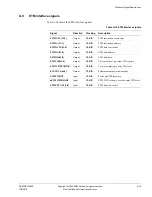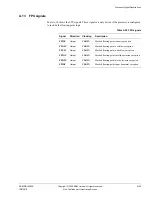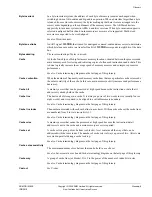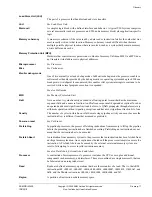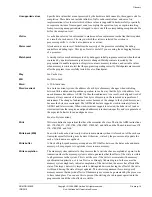
Glossary
ARM DDI 0363E
Copyright © 2009 ARM Limited. All rights reserved.
Glossary-5
ID013010
Non-Confidential, Unrestricted Access
Base register write-back
Updating the contents of the base register used in an instruction target address calculation so that
the modified address is changed to the next higher or lower sequential address in memory. This
means that it is not necessary to fetch the target address for successive instruction transfers and
enables faster burst accesses to sequential memory.
Beat
Alternative word for an individual transfer within a burst. For example, an INCR4 burst
comprises four beats.
See also
Burst.
BE-8
Big-endian view of memory in a byte-invariant system.
See also
BE-32, LE, Byte-invariant and Word-invariant.
BE-32
Big-endian view of memory in a word-invariant system.
See also
BE-8, LE, Byte-invariant and Word-invariant.
Big-endian
Byte ordering scheme in which bytes of decreasing significance in a data word are stored at
increasing addresses in memory.
See also
Little-endian and Endianness.
Big-endian memory
Memory in which:- a byte or halfword at a word-aligned address is the most significant byte or
halfword within the word at that address - a byte at a halfword-aligned address is the most
significant byte within the halfword at that address.
See also
Little-endian memory.
Block address
An address that comprises a tag, an index, and a word field. The tag bits identify the way that
contains the matching cache entry for a cache hit. The index bits identify the set being
addressed. The word field contains the word address that can be used to identify specific words,
halfwords, or bytes within the cache entry.
See also
Cache terminology diagram on the last page of this glossary.
Branch prediction
The process of predicting if conditional branches are to be taken or not in pipelined processors.
Successfully predicting if branches are to be taken enables the processor to prefetch the
instructions following a branch before the condition is fully resolved. Branch prediction can be
done in software or by using custom hardware. Branch prediction techniques are categorized as
static, in which the prediction decision is decided before run time, and dynamic, in which the
prediction decision can change during program execution.
Breakpoint
A breakpoint is a mechanism provided by debuggers to identify an instruction at which program
execution is to be halted. Breakpoints are inserted by the programmer to enable inspection of
register contents, memory locations, variable values at fixed points in the program execution to
test that the program is operating correctly. Breakpoints are removed after the program is
successfully tested.
See also
Watchpoint.
Burst
A group of transfers to consecutive addresses. Because the addresses are consecutive, there is
no requirement to supply an address for any of the transfers after the first one. This increases
the speed at which the group of transfers can occur. Bursts over AHB or AXI buses are
controlled using the
xBURST
signals to specify if transfers are single, four-beat, eight-beat, or
16-beat bursts, and to specify how the addresses are incremented.
See also
Beat.
Byte
An 8-bit data item.

